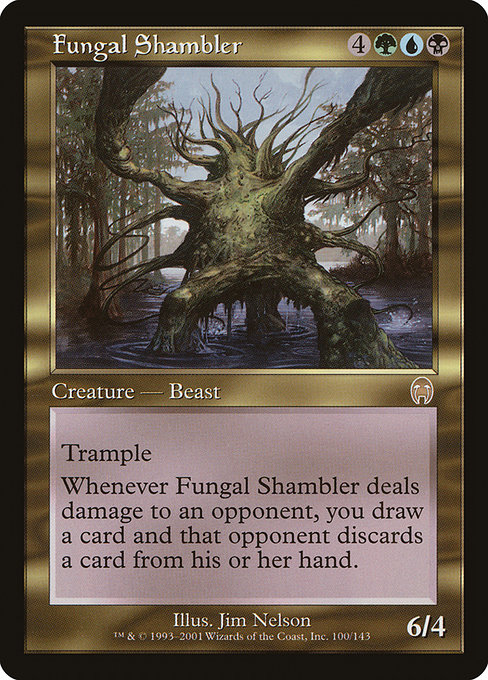
Image courtesy of Scryfall.com
Designing for Every MTG Playstyle: a Look Through Fungal Shambler
Magic: The Gathering has always rewarded players for understanding the moment, not just the curve. That’s why empathic design—crafting cards that speak to a spectrum of strategies—remains a cornerstone of the game’s enduring appeal. Enter Fungal Shambler, a rare creature from Apocalypse that embodies how a single card can flex across control, midrange, and even casual Commander games. This 7-mana powerhouse, with the tri-color identity of Black, Green, and U Blue, is a compact study in intentional design🧙♂️🔥.
From the moment you see its mana cost—{4}{B}{G}{U}—you know this isn’t a trump card for a fast aggro plan. It’s a late-game behemoth that rewards careful ramp and precise combat decisions. Fungal Shambler’s 6/4 stats don’t scream “game ender,” but the real payoff is its rules text: Trample and, whenever it deals damage to an opponent, you draw a card and that opponent discards a card. That isn’t just card advantage; it’s hand disruption in a riff with a hammer—the perfect emblem of how design can honor multiple playstyles in one frame. It’s the kind of blend that makes esports-level control players smile and midrange fans lean back in their chairs with a satisfied nod 💎⚔️.
Flavorwise, the card leans into a fungal nightmare that overgrows the battlefield—an image that resonates with players who love games about resource control and inevitability. The fact that it requires three colors underscores a deliberate design choice: true multi-color identity isn’t just a flashy symbol; it’s a signal that your deck will need to balance mana fixing, tempo, and the risk-reward calculus of a late-game beater. That tri-color identity invites players to sculpt decks that can flex from counterspells to recursion to ramp, ensuring the same card can slot into strategies that otherwise feel divergent. In practice, that means even a control player can lean into a swamp-tinged, card-drawn victory by deploying Shambler as a late-game threat that punishes the opponent for overextending or mismanaging their hand 💣🎲.
So how does this design actually support diverse playstyles in real games? For control players, Shambler is a top-end finisher that can close a game once mana is ramped and protection is woven into the plan. Its draw-and-discard trigger pairs nicely with wheels and cantrip suites, turning a single swing into a cascade of advantage. For midrange players, the card’s raw body—6 power on a 7-mana frame—offers a formidable clock that demands answers while continuing to accrue value on each hit. The trample ability ensures even if blockers slip in, damage pressure persists, nudging opponents toward defensive plays that open your other options. For casual and Commander players, the card’s resilience and disruptive edge provide a rallying point: you’re not simply beating down; you’re trading incremental wins for a longer, more interactive game that rewards planning and cooperation with the board state 🧙♂️🔥.
Designers often walk a tightrope with multi-color epic threats like Fungal Shambler. A card this potent must avoid eclipsing other cards in its color pairings and sets, so it lands with the right cadence. Apocalypse, a set defined by its post-apocalyptic vibe and distinct frame, houses Shambler in a way that encourages players to plan for both the long game and the moment-to-moment battles. Its rarity—rare—signals to collectors and players alike that this card is a meaningful investment in a deck’s late-game trajectory. The fact that Shambler is legal in formats like Legacy and Commander—where multi-color strategies are lauded—speaks to its design flexibility: it isn’t a one-trick pony; it’s a strategic fulcrum that can pivot to match the deck’s goals, from control victory through card advantage to aggressive pressure when the board is primed 🔥💎.
To designers and players alike, Fungal Shambler is a reminder that empathy for playstyles isn’t about catering to every whim with a single card. It’s about creating a shared space where diverse routes to victory are visible, reinforcing the idea that the same battlefield can feel different depending on what a player values. For some, it’s the thrill of a well-timed discard to destabilize the opponent’s plans; for others, it’s the satisfaction of a clean, big-body attack that ignores the math of blockers. And for everyone, it’s the whisper of possibility: a turn where a careful calculation flips the script and leaves both players reevaluating how they approach the next twelve cards in their library 🧙♂️🎨.
If you’re chasing a tactile, real-world way to carry these MTG moments offline, consider pairing your game night with a practical accessory that travels as well as your concepts do. The phone case with card holder magnetic MagSafe by Digital Vault blends form and function in a way that feels as thoughtfully designed as a well-tuned deck. It’s tactile proof that thoughtful product design—like a well-timed Shambler swing—can elevate everyday experiences just as grittily and elegantly as a well-constructed mana curve.
Phone Case with Card Holder MagSafe Polycarbonate Glossy Matte
More from our network
- https://blog.digital-vault.xyz/blog/post/why-digital-paper-transforms-moodboards-and-creativity/
- https://crypto-acolytes.xyz/blog/post/blue-white-star-illuminates-mass-temperature-link/
- https://blog.digital-vault.xyz/blog/post/callous-giant-in-limited-draft-strategy-and-value/
- https://crypto-acolytes.xyz/blog/post/reliving-the-golden-era-of-arcade-cabinets/
- https://crypto-acolytes.xyz/blog/post/minecraft-boss-fights-ranked-the-definitive-tier-list/